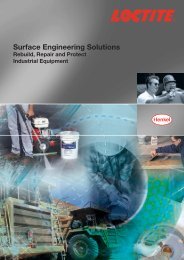Structural Bonding
Structural Bonding
Structural Bonding
You also want an ePaper? Increase the reach of your titles
YUMPU automatically turns print PDFs into web optimized ePapers that Google loves.
108<br />
Threadlocking<br />
In the last fifty years, the introduction of liquid anaerobic threadlockers has dramatically increased<br />
the reliability of threaded fasteners. In fact, since their introduction, liquid anaerobic products have<br />
become one of the most reliable ways to ensure that a threaded assembly will remain locked and<br />
leak-proof for the service life of the assembly.<br />
When used to assemble threaded fasteners, Loctite®<br />
threadlockers are vastly superior to mechanical locking<br />
devices. Applied drop-wise to the threads of a fastener,<br />
the anaerobic liquid cures to a hard thermoset plastic<br />
that locks the threads together, preventing unwanted<br />
movement or loosening, leaks, and corrosion.<br />
To further enhance their performance, unique<br />
anaerobic formulations have been developed for<br />
applications with high temperatures,<br />
oil contamination, and less reactive surfaces.<br />
Loctite® threadlockers have historically been formulated<br />
as liquids due to their reactivity, and to ensure they<br />
remain stable and ready to use. Recent breakthroughs<br />
have led to the development of stable, semisolid stick<br />
formulations. This has opened the door to applications<br />
where the liquids were considered too messy or<br />
inconvenient. These new semisolid formulations allow<br />
direct contact of the anaerobic product to the part. This<br />
ensures not only that the product is placed exactly where<br />
it is needed, but also that it stays there as the threaded<br />
part is positioned and assembled.<br />
Threadlockers<br />
Threaded fasteners continually receive various types<br />
of differential stress. Stresses, such as vibration and<br />
shock, thermal expansion and contraction, and<br />
micro-movement of the fastened parts, can all reduce<br />
clamping force and ultimately cause machine failure.<br />
Many mechanical devices, such as spring washers, wire<br />
retainers and locking bolts, were developed to prevent<br />
uncontrolled loosening of fasteners. These locking<br />
methods add substantial cost to the fastener assembly,<br />
yet cannot reliably prevent loosening due to their<br />
uneven side or sliding motion. They also do not seal or<br />
prevent corrosion within the fastener assembly and must<br />
be sized appropriately for the specific fastener.<br />
Threadlockers are available in low strength formulations<br />
for easy removal, medium strength grades that are<br />
removable using common hand tools, and high strength<br />
grades that offer strong holding abilities. However, no<br />
threadlocker is completely permanent; standard hand<br />
tools remove even the highest- strength threadlockers<br />
following direct exposure to heat (450°F to 500°F) for<br />
about five minutes.<br />
Contrary to common belief, any bolt previously locked<br />
with threadlocking adhesive is reusable simply by<br />
removing the old adhesive, applying new threadlocking<br />
material and reassembling.<br />
This chart should not be used to specify products without specific<br />
testing. It is recommended that you conduct on-part testing to<br />
ensure product performance before specifying any threadlocker.<br />
Loctite® Adhesives and Sealants Product Specialists are available to<br />
assist you with new product designs, or to help you re- engineer an<br />
existing application for improved performance and cost savings.<br />
They can also set up testing of your parts at the Henkel Customer<br />
Engineering Center. For application assistance, call 1-800-LOCTITE<br />
(562- 8483) or visit www.loctite.com and select “Contact Loctite.” In<br />
Canada, please call 1-800-263-5043.



